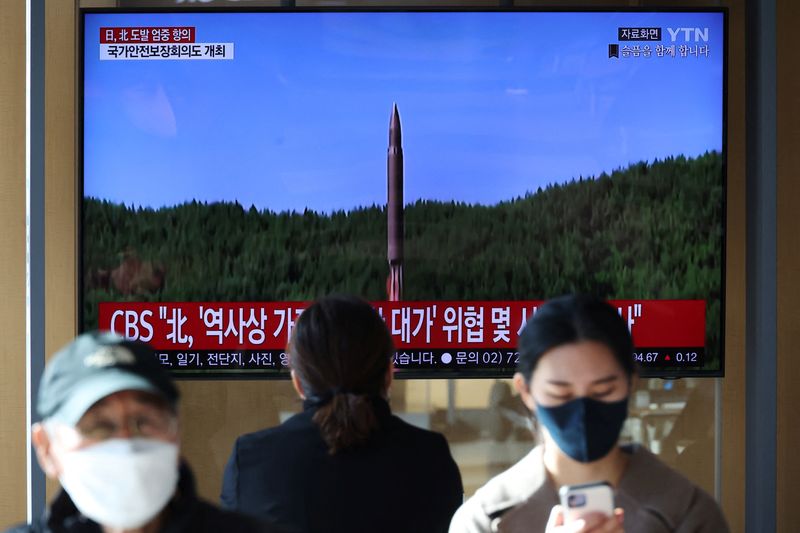Analysis-Why is North Korea testing so many missiles?
2022.11.03 04:48
[ad_1]

© Reuters. People watch a TV broadcasting a news report on North Korea firing a ballistic missile off its east coast, in Seoul, South Korea, November 2, 2022. REUTERS/Kim Hong-Ji
By Josh Smith
SEOUL (Reuters) – The hundreds of South Korean and American warplanes simulating attacks during drills are most likely what led North Korea to test a record number of missiles this week, experts say, but Pyongyang may also be turning up the heat before a nuclear test.
Analysts say North Korean leader Kim Jong Un seems to genuinely dislike the allied drills, and particularly the involvement of U.S. stealth fighters.
“North Korea really does not like these large combined air exercises, especially since they employ F-35s that can be used for decapitation strikes against the regime and are very difficult for North Korean air defences to pick up,” said Mason Richey, a professor at Hankuk University of Foreign Studies in Seoul.
Just hours before launching 23 missiles of various types into the sea on Wednesday – the most in one day – North Korea issued another condemnation of the Vigilant Storm drills, which involve around 240 South Korean and U.S. warplanes flying missions around the clock.
The barrage of missile launches and the prospect of a new nuclear test underscore the limited options Washington and its allies have for preventing Pyongyang from advancing its weapons programmes, with the allies turning to major military exercises to “deter” war even as some current and former U.S. officials say they may contribute to tensions.
After North Korea conducted an apparent intercontinental ballistic missile (ICBM) test on Thursday, the allies announced they would be extending Vigilant Storm past Friday.
North Korea also tests and demonstrates its weapons for other reasons, including technical progress, propaganda value, exercising crew readiness and capability, and demonstrating that deterrence goes both ways, Richey said.
‘INCREASE DETERRENCE’
Analysts have said the F-35 puts North Korea’s anti-aircraft and anti-missile defence systems in a vulnerable position, with Pyongyang saying last year that the use of the jets by South Korea and the United States has forced it to develop new missiles to “completely destroy” such threats.
After a flurry of missile tests last month, North Korea said it was simulating showering the South with tactical nuclear weapons on targets such as military bases and airports.
Takashi Kawakami, professor at Takushoku University in Tokyo, noted that among other military movements the United States had recently begun forward-deploying offensive weapons, including rotations of F-22 stealth fighters in Okinawa.
“North Korea is aiming to increase its deterrence capabilities,” he said.
This week’s military activities show what the opening hours of a high intensity peninsular war could involve, including large-scale allied air operations and simultaneous salvos from multiple North Korean missile and artillery systems, Adam Mount, director of the Defense Posture Project at the Federation of American Scientists, said on Twitter.
The simultaneous launches of short- and long-range missiles and other weapons is ominous because they suggest that North Korea is practicing plans to attack distant U.S. targets during a conflict on peninsula, he said.
NUCLEAR TEST?
North Korea began its record year of tests before the allies had resumed major drills, and its response to the latest exercises suggests it may be setting the stage for something bigger, some analysts said.
“(The) launches were not the usual response to allied exercises,” Mount said of Pyongyang’s unprecedented firing of 23 missiles on Wednesday. “They were calibrated escalate tensions. If North Korea prefers to conduct a nuclear test in a crisis, it is well on its way to manufacturing one.”
North Korea has completed all the technical preparations for a nuclear test – its first since 2017 – according to South Korean and U.S. officials.
Mount said Kim may prefer to conduct a nuclear test amid heightened tensions for several reasons, including increasing the impact of the test, shaping how the United States and its allies perceive the test, diluting the international response, or helping Pyongyang assuage China. Beijing dislikes nuclear tests on its doorstep but has also blamed Washington and Seoul for exacerbating the situation.
“In terms of politics and diplomacy, Kim’s focus is on pressing the United States ahead of its midterm elections into withdrawing hostile policies by emphasising to voters that the Biden administration’s North Korea policy has failed,” said Yang Moo-jin, a professor at the University of North Korean Studies in Seoul.
Kim also wants to bolster internal support for his government during economic hardship at home and demonstrate that when it comes to the Korean peninsula issues, he is in the driver’s seat, Yang said.
“Kim would likely be seeking to earn tacit recognition as a nuclear weapons state and negotiate nuclear disarmament with the United States by making North Korea’s denuclearization an unrealistic goal,” said Park Won-gon, a professor at Ewha Womans University in Seoul.
[ad_2]
Source link








